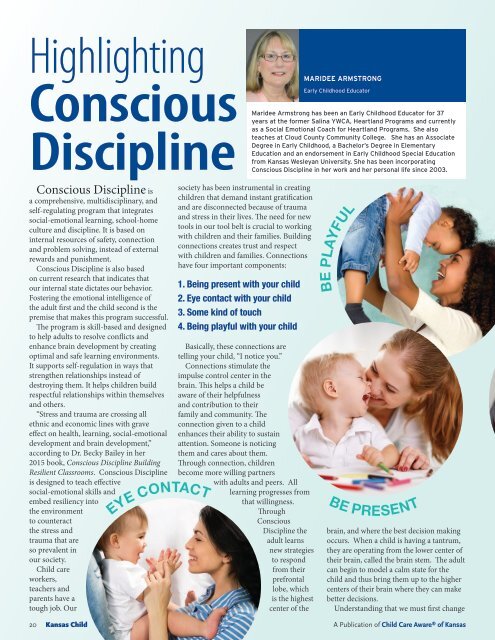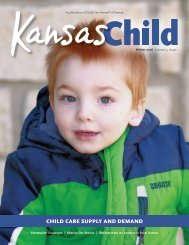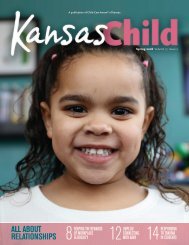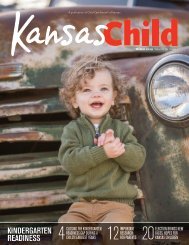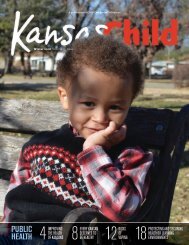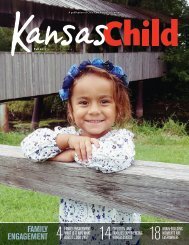2018 Spring Kansas Child
You also want an ePaper? Increase the reach of your titles
YUMPU automatically turns print PDFs into web optimized ePapers that Google loves.
Highlighting<br />
Conscious<br />
Discipline<br />
MARIDEE ARMSTRONG<br />
Early <strong>Child</strong>hood Educator<br />
Maridee Armstrong has been an Early <strong>Child</strong>hood Educator for 37<br />
years at the former Salina YWCA, Heartland Programs and currently<br />
as a Social Emotional Coach for Heartland Programs. She also<br />
teaches at Cloud County Community College. She has an Associate<br />
Degree in Early <strong>Child</strong>hood, a Bachelor’s Degree in Elementary<br />
Education and an endorsement in Early <strong>Child</strong>hood Special Education<br />
from <strong>Kansas</strong> Wesleyan University. She has been incorporating<br />
Conscious Discipline in her work and her personal life since 2003.<br />
Conscious Discipline is<br />
a comprehensive, multidisciplinary, and<br />
self-regulating program that integrates<br />
social-emotional learning, school-home<br />
culture and discipline. It is based on<br />
internal resources of safety, connection<br />
and problem solving, instead of external<br />
rewards and punishment.<br />
Conscious Discipline is also based<br />
on current research that indicates that<br />
our internal state dictates our behavior.<br />
Fostering the emotional intelligence of<br />
the adult first and the child second is the<br />
premise that makes this program successful.<br />
The program is skill-based and designed<br />
to help adults to resolve conflicts and<br />
enhance brain development by creating<br />
optimal and safe learning environments.<br />
It supports self-regulation in ways that<br />
strengthen relationships instead of<br />
destroying them. It helps children build<br />
respectful relationships within themselves<br />
and others.<br />
“Stress and trauma are crossing all<br />
ethnic and economic lines with grave<br />
effect on health, learning, social-emotional<br />
development and brain development,”<br />
according to Dr. Becky Bailey in her<br />
2015 book, Conscious Discipline Building<br />
Resilient Classrooms. Conscious Discipline<br />
is designed to teach effective<br />
social-emotional skills and<br />
embed resiliency into<br />
the environment<br />
to counteract<br />
the stress and<br />
trauma that are<br />
so prevalent in<br />
our society.<br />
<strong>Child</strong> care<br />
workers,<br />
teachers and<br />
parents have a<br />
tough job. Our<br />
EYE CONTACT<br />
society has been instrumental in creating<br />
children that demand instant gratification<br />
and are disconnected because of trauma<br />
and stress in their lives. The need for new<br />
tools in our tool belt is crucial to working<br />
with children and their families. Building<br />
connections creates trust and respect<br />
with children and families. Connections<br />
have four important components:<br />
1. Being present with your child<br />
2. Eye contact with your child<br />
3. Some kind of touch<br />
4. Being playful with your child<br />
Basically, these connections are<br />
telling your child, “I notice you.”<br />
Connections stimulate the<br />
impulse control center in the<br />
brain. This helps a child be<br />
aware of their helpfulness<br />
and contribution to their<br />
family and community. The<br />
connection given to a child<br />
enhances their ability to sustain<br />
attention. Someone is noticing<br />
them and cares about them.<br />
Through connection, children<br />
become more willing partners<br />
with adults and peers. All<br />
learning progresses from<br />
that willingness.<br />
Through<br />
Conscious<br />
Discipline the<br />
adult learns<br />
new strategies<br />
to respond<br />
from their<br />
prefrontal<br />
lobe, which<br />
is the highest<br />
center of the<br />
BE PLAYFUL<br />
BE PRESENT<br />
brain, and where the best decision making<br />
occurs. When a child is having a tantrum,<br />
they are operating from the lower center of<br />
their brain, called the brain stem. The adult<br />
can begin to model a calm state for the<br />
child and thus bring them up to the higher<br />
centers of their brain where they can make<br />
better decisions.<br />
Understanding that we must first change<br />
20 <strong>Kansas</strong> <strong>Child</strong> A Publication of <strong>Child</strong> Care Aware ® of <strong>Kansas</strong>


